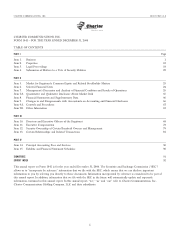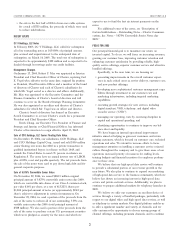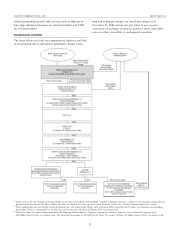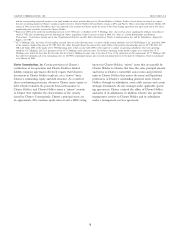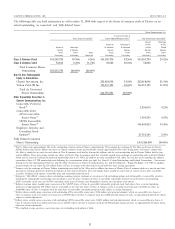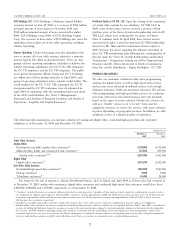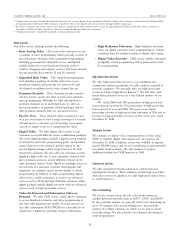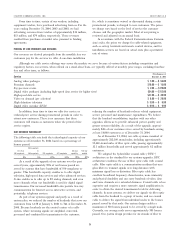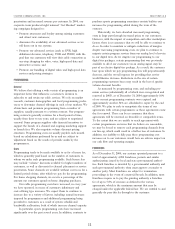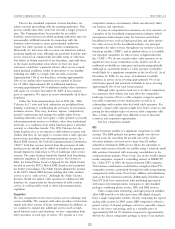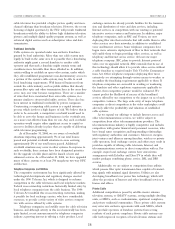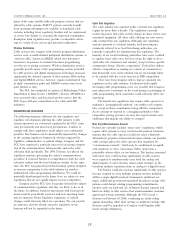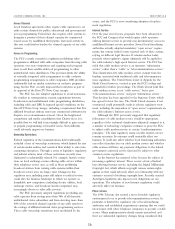Charter 2004 Annual Report Download - page 17
Download and view the complete annual report
Please find page 17 of the 2004 Charter annual report below. You can navigate through the pages in the report by either clicking on the pages listed below, or by using the keyword search tool below to find specific information within the annual report.
CHARTER COMMUNICATIONS, INC. 2004 FORM 10-K
CCO Holdings, LLC. CCO Holdings, a Delaware limited liability Preferred Equity in CC VIII, LLC. Upon the closing of the acquisition
company formed on June 12, 2003, is a co-issuer of $500 million of certain cable systems by our subsidiary, CC VIII, LLC, in
principal amount of notes issued in November 2003 and 2000, some of the former owners received a portion of their
$550 million principal amount of notes issued in December purchase price in the form of preferred membership units in CC
2004. CCO Holdings owns 100% of CCO Holdings Capital VIII, LLC, which were exchangeable for shares of Charter
Corp., the co-issuer of these notes. CCO Holdings also owns the Class A common stock. In April 2002, these former owners
subsidiaries that conduct all of our cable operations, including exercised their right to put their preferred CC VIII membership
Charter Operating. interests to Mr. Allen and this transaction closed on June 6,
2003. An issue has arisen regarding the ultimate ownership of
Charter Operating. Charter Operating owns the subsidiaries that these CC VIII membership units following the consummation of
own or operate all of our cable systems, subject to a minority this put right. See ‘‘Item 13. Certain Relationships and Related
interest held by Mr. Allen as described below. There are four Transactions — Transactions Arising out of Our Organizational
groups of these operating subsidiaries, identified as follows: the Structure and Mr. Allen’s Investment in Charter Communica-
Charter Operating subsidiaries, the CC V/CC VIII companies, tions, Inc. and Its Subsidiaries — Equity Put Rights — CC VIII.’’
the CC VI companies, and the CC VII companies. The public
notes issuers, Renaissance Media Group and CC V Holdings, PRODUCTS AND SERVICES
are within two of these groups and prior to April 2004, each We offer our customers traditional cable video programming
group of operating subsidiaries had a separate credit facility. The (analog and digital video) as well as high-speed data services
credit facilities for the CC V/CC VIII companies, the CC VI and in some areas advanced broadband services such as high
companies and the CC VII companies were all refinanced in definition television, VOD and interactive television. We sell our
April 2004 in connection with the amendment and restatement video programming and high-speed data services on a subscrip-
of the CCO credit facilities. See ‘‘Item 7. Management’s tion basis, with prices and related charges, that vary primarily
Discussion and Analysis of Financial Condition and Results of based on the types of service selected, whether the services are
Operations — Liquidity and Capital Resources.’’ sold as a ‘‘bundle’’ versus on an ‘`a la carte’’ basis, and the
equipment necessary to receive the services, with some variation
in prices depending on geographic location. In addition, we offer
telephony service to a limited number of customers.
The following table summarizes our customer statistics for analog and digital video, residential high-speed data and residential
telephony as of December 31, 2004 and December 31, 2003.
Approximate as of
December 31, December 31,
2004(a) 2003(a)
Cable Video Services:
Analog Video:
Residential (non-bulk) analog video customers(b) 5,739,900 6,173,400
Multi-dwelling (bulk) and commercial unit customers(c) 251,600 257,900
Analog video customers(b)(c) 5,991,500 6,431,300
Digital Video:
Digital video customers(d) 2,674,700 2,671,900
Non-Video Cable Services:
Residential high-speed data customers(e) 1,884,400 1,565,600
Dial-up customers 3,800 9,600
Telephony customers(f) 45,400 24,900
Pro forma for the sale of systems to Atlantic Broadband Finance, LLC in March and April 2004 as if these sales had occurred as
of December 31, 2003, analog video customers, digital video customers and residential high-speed data customers would have been
6,200,500, 2,588,600 and 1,527,800, respectively, as of December 31, 2003.
(a) ‘‘Customers’’ include all persons our corporate billing records show as receiving service (regardless of their payment status), except for complimentary accounts (such as
our employees). In addition, at December 31, 2004 and 2003, ‘‘customers’’ include approximately 44,700 and 72,700 persons whose accounts were over 60 days past due
in payment, approximately 5,200 and 6,500 persons, whose accounts were over 90 days past due in payment and approximately 2,300 and 2,000 of which were over
120 days past due in payment, respectively.
(b) ‘‘Residential (non-bulk) analog video customers’’ include all customers who receive video services, except for complimentary accounts (such as our employees).
(c) Included within ‘‘video customers’’ are those in commercial and multi-dwelling structures, which are calculated on an equivalent bulk unit (‘‘EBU’’) basis. EBU is calculated for
a system by dividing the bulk price charged to accounts in an area by the most prevalent price charged to non-bulk residential customers in that market for the comparable
tier of service. The EBU method of estimating analog video customers is consistent with the methodology used in determining costs paid to programmers and has been
consistently applied year over year. As we increase our effective analog prices to residential customers without a corresponding increase in the prices charged to commercial
service or multi-dwelling customers, our EBU count will decline even if there is no real loss in commercial service or multi-dwelling customers.
7




